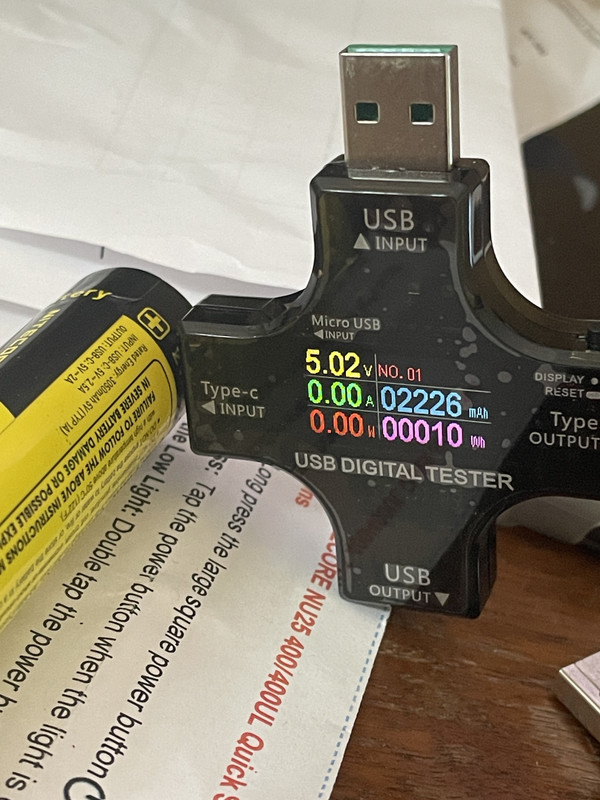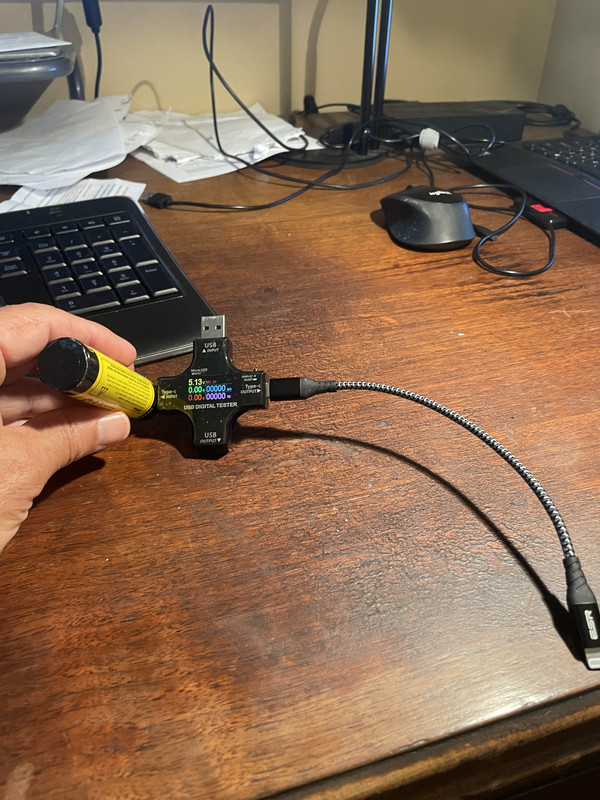I bought this Nitecore USB-C 21700 cell as a light powercell for charging my phone. Both times I’ve used it I feel like it didn’t charge my phone as expected. Today I full drained it, then charged it while connected to a USB tester. It was my first time using the tester so not sure I am assessing the display properly. It stopped charging after only 2226 mAh - right?
I checked with a voltmeter and cell was at 4.19v
When I test one of my cells in an analyzing charger, it first tops it up. Then it drains the cell while the meter runs, and last it tops it up again. The output of the cell while drained is the way the capacity is measured.
OK, maybe I was doing it wrong. The cell thinks it is fully charged so I’ll just charge something and see if I can get close to 5000mAh out of it. Thanks!
I am charging something from it now. Before I plugged it in to the device I noticed the tester was reporting the voltage as 5.13v. Does that seem correct? I know the cell resting voltage was 4.19 earlier.
Keep in mid the above. Capacity is not measured when charging the cell. Rather it is measured when discharging it. When you said you drained the cell, how did you tell that it was fully discharged?
Most lights with LVP do not drain the cell to the same level that the manufacturers do when determining the capacity for their labels or data sheets. LVP often shuts the light down at close to 3 volts. Many manufacturers go to 2.5 volts. So this can contribute to the lower capacity that you saw going into the cell.
Another thing, if I get within 10 to 15% of the rated capacity when testing a cell, I usually am OK with that. Not really happy, but I accept it as typical. At least with the way I measure.
It has to step up the battery voltage to provide the 5V that devices need to charge them. So you will not see the battery voltage on the USB output, but rather the upconverted/boosted voltage.
The cell cutoff when I was using it to charge a device, so I assume it was drained.
Nope… tat least not for the purposes of capacity testing. It protects itself at a higher level than what is fully discharged. I don’t find the reading that you got unusual based on what you are doing.
How to I drain it further than it’s own internal cutoff? I’m testing it as I suspect it isn’t giving me the capacity I expect.
During my drain test I just completed it - I let it charge a medium device until the cell cut off - it only provided 2101 mAh as per my tester.
The first time or two I used this battery I know it charged my iPhone 12 ( 2,815 mAh) about 1.7 times. Then the last 2 times I used it I’m only getting around 1 charge of the phone. So my testing and output seems to mirror what I’m experiencing. That said I recognize I’m new to using this tester and waned to understand if I had things right before requesting a replacement cell.
Yes. Was the cell really empty?
That is a good question. The way I test cells is using the main terminals on the cell in a dedicated tester. This tests the cells capacity without the circuitry for USB involved. This is also closer to the way that Nitecorp tests the cell to determine the rated capacity. There are losses involved the the boost circuit that allows you to charge devices with the cell. Maybe the results that you are seeing are typical for that cell and circuitry. I don’t know. Perhaps you might be better off getting a higher capacity power bank if you want more charges for your phone. Even then, don’t plan on getting the advertised capacity. I have a few of the 40 Ah (40,000 mAh) internal battery rated power banks. None of them give me more than around 28 Ah. I wouldn’t expect too much from a single 21700 cell in charging device. Consider my phone has a 5000 mAh internal battery. Theoretically that cell could charge it once from empty… But really it wouldn’t because of the losses involved.
I haven’t used that particular cell, but I have an idea that what you are seeing does not mean it is defective.
Honestly I have nothing to offer on what you saw initially and what it is doing now. There are too many variables that we don’t know about.
When using a LiIon cell to charge other LiIon cells via the USB protocol you can expect to get 50-60% out of the nominal capacity in real life. The rest is lost to voltage conversion inefficiencies.

